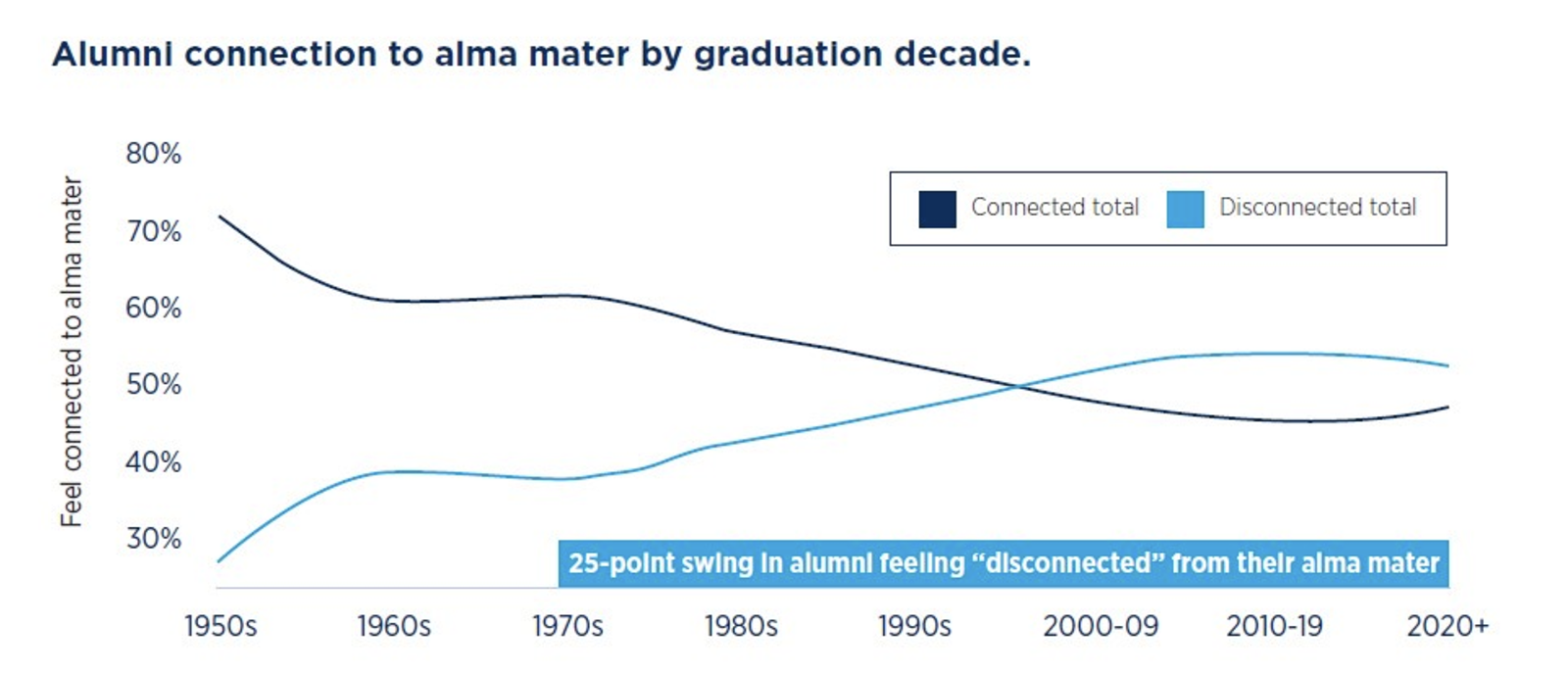
This sponsored content represents the views and opinions of the author and has been made available for informational and educational purposes only. AGB does not make any representation or warranty with respect to the accuracy, originality, or completeness of this content.
RNL recently released the results of the 2024 National Alumni Survey, with responses from more than 20,000 American higher education alumni. The survey invited alumni to share feedback about their giving and volunteering habits, their feeling of connection to their alma mater, and what inspires their generosity.
I have been honored to serve as an advisor and collaborate closely with senior consultant Sarah Kleeberger on this groundbreaking survey project, as I have been thinking critically for quite some time about how our behaviors as fundraisers do not match the way that people give today, and I have watched us suffer a massively declining alumni donor base. It is time for innovative approaches.
As presidents, chancellors, and trustees work with their advancement offices to build a healthy pipeline of alumni support, understanding three important highlights from the survey is critical in order to transform how fundraisers connect with alumni populations before it is too late.
1. Connected and engaged alumni are ready to give, but there are too few of them.
Older alumni feel much more connected to their alma mater, with only 46 percent of alumni from 2010 forward saying they feel “connected.” Why does this matter? The survey also tracked giving behavior, and alumni who feel connected are 23 times more likely to give.
Unfortunately, fundraising outreach is geared to something different. Too often, advancement systems are geared to chase wealth, and outreach is about asking, not connecting. It is clear from this survey that the focus should be on building connection, which alumni are telling us is crucial in their giving decisions. Gifts follow connection.
2. It is time to stop telling alumni how to give and embrace their personal passions.
The survey identified two major challenges for fundraisers. First, engagement systems do not reflect who our alumni are today. Second, there is often resistance to changing the systems designed to meet changing alumni needs.
There is a tendency to focus on big gifts. That is not surprising, and in many ways it is justifiable. Also, fundraisers approach givers with institutional priorities, not their personal passions. The dollar amounts for “annual givers” are too low, and many advancement and institutional leaders view the donor’s value as too minimal. By necessity, these leaders think in terms of raising millions of dollars, which leaves them to invest minimally in innovation at lower donor levels.
I must admit, I am part of the system that has failed our alumni.
Fundraising is on the cusp of bringing incredible technology to the field, powered by predictive analytics and artificial intelligence. This technology allows for the ability to be better listeners to alumni preferences and match up outreach to their interests. As this is done, there must be a commitment to using these new tools to listen to what constituents value and present them with a greater breadth of opportunities rather than force giving to areas of our own priority.
Intriguingly, younger alumni are very attuned to the key needs for which we are all trying to raise money. Undergraduates of the last decade stated they are more likely to support mental health services; student emergency funds; diversity, equity, and inclusion (DEI); and first-generation student initiatives—all areas that impact student success goals.
It seems evident that we have been trying for too long to “teach” alumni how to give. Today’s alumni, especially millennials and members of Generation Z, give based on impact and what they are enthusiastic about. They give in the way they want to contribute—not how we tell them. It is time to listen and reflect that we are listening to them.
3. Alumni are ready to give for impact based on connection.
The RNL National Alumni Survey offers incredible insights for advancement professionals. I encourage you to download the full report.
I also urge you to think critically about how your engagement efforts can shift to better match the needs and preferences of today’s alumni. We have an opportunity to reimagine how alumni connect and support institutions, but time is short. As the report explains, the declining alumni giving rates mean we will soon face an alumni donor “cliff” as we lose older, loyalty-based givers. This cliff negatively impacts the pipeline of major gift prospects and will cause a potentially massive decline in overall giving. There is no time like the present to fully engage donors to strive for a better tomorrow.
If you are interested in participating in the next national survey project, please contact RNL at Linda.Hoopes@Ruffalonl.com.
Howard Heevner is the executive director of annual programs at the University of California, Berkeley, a leadership role he has held since 2019.
With Thanks to AGB Mission Partner: RNL





